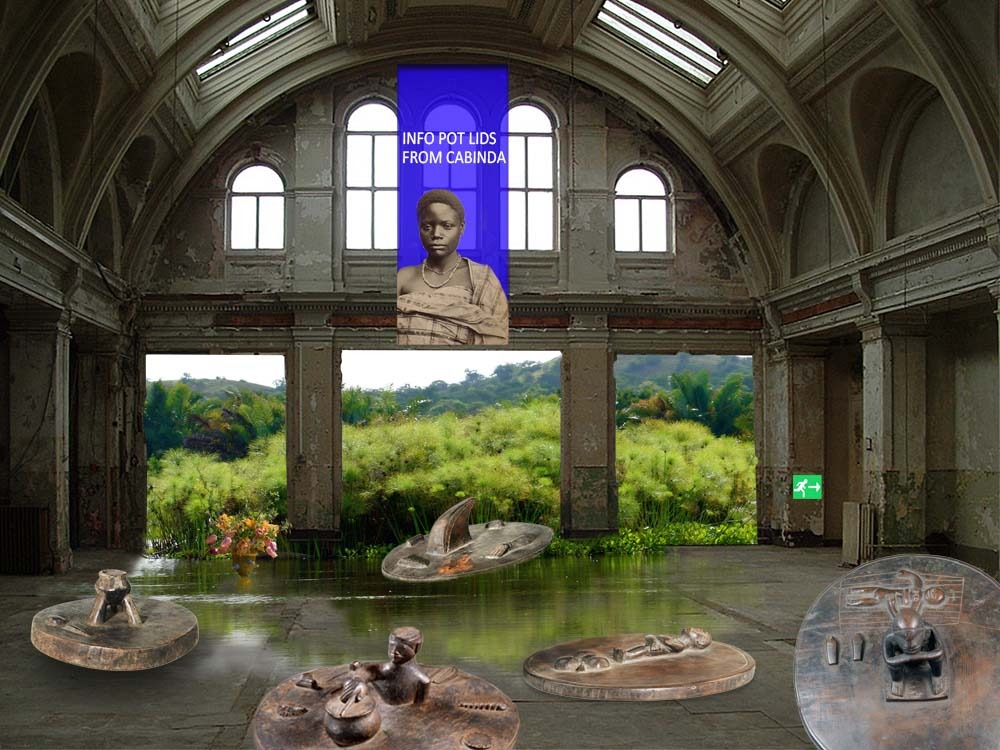



















Please read the general information about the potlids from Cabinda!
Potlid nr. 1
Main subject: cooking pot on three cooking stones
Proverb: 'Three stones are needed to balance a cooking pot'
Additional symbols: sea shell and nut
Meaning: Our marriage is off balance. A good marriage needs three things: children, clothing and food. I am very angry (sea shell) and my irritation surfaces again and again (nut).
Collection: National Museum of World Cultures, the Netherlands


Please read the general information about the potlids. Click on the info button on the banner
Potlid nr. 3
Main subject: a cock's tail
Proverb: 'It starts right but ends bend'
Additional symbols: a seashell, an arm with one bracelet, a piece of wood, palm nut
Meaning: You used to be a good boy, but you have changed.
I cannot withhold anymore (sea shell) that you do things that are wrong (piece of wood). If you do not want to lose me you have to watch out; there are plenty of men who would like to have me (palm nut). Man and wife should help each other: with one bracelet you can’t jingle.
Collection: National Museum of World Cultures, the Netherlands


Please read the general information about the potlids from Cabinda!
Potlid nr. 4
Main subject: a sick woman
Proverb: "Whoe those without clan!"
Additional symbols: three cooking stones without cooking pot
Interpretation: I have no clan to help me; three things are needed in a marriage: children, clothing and both have to bring in food. There is not enough food because you don't work.
Collection: National Museum of World Cultures, the Netherlands


Please also read the general information about the potlids by clicking on the INFO button on the red banner!
Potlid nr. 2
Main figure: Fortune teller
Sub figures:
Clockwise, to begin with the peanut:
Moon, sun, seashell, fruit, old pipe, new pipe, marriage fetish
Proverb: I wish I had been to the fortune teller before our marriage
Interpretation : I wish I had visited the fortune teller, then I would not have married you. But now we are married (the fetish), I feel forced to tell you about my anger (seashell). I have given everything to you: sex (fruit) and children (peanut), but now you want to outcast me because I’m old (old pipe) and marry a young woman (new pipe). I don’t accept that, because who is the strongest? It’s not you (sun), but me (moon) because of my children.
Collection: National Museum of World Cutures, the Netherlands


Please also read the general information about the potlids. Click on the info button on the red banner.
Potlid nr. 5
The Brooklyn Museum does not give an interpretation of the symbols on this pot lid. So let's try it our selves:
In center, a man on a slightly elevated base sits with elbows on knees and chin on forearms. Behind his back lies a woman on a mat. Next to the man two bottles......
Collection: Brooklyn Museum, New York, USA




Pot Lids from Cabinda or the Riddle of their Message
In Western Africa proverbs serve as a rich repository of encapsulated wisdom. Museum objects collected in this area often incorporate visual references to these proverbial sayings.
Wooden, sculptured pot lids from Cabinda (a province of Angola) are an unique example of this – vanished - tradition.
The figures carved in relief refer to proverbs deeply rooted in traditional Woyo culture. They are based on existing proverbs and legends, but their meanings also depended on the context in which they appeared to the family and the clan. They were used as transmitters of advices, values or warnings.
With her collection of pot lids a Woyo woman possessed a powerful and sophisticated tool to express her displeasure about her marriage.
After marriage a woman settled with the clan of her husband. She depended on him, marital relations did not allow her to voice criticisms overtly to her husband. The food was prepared by her, they ate separately though, he with his clansmen, she with the children. With her collection of pot lids she was able to force her husband to good behavior.
If a woman, for example, thought her marriage was in crises then she would use a special cover for his meal. It signaled her final effort to make him understand. What exactly this message was would be told by the symbolic renderings of proverbs carved on the cover. The pot contained a nicer sauce than usual, but the carved cover would not remain unnoticed by the other men. It could not be hidden. And whatever the overt message, it would entail a serious threat: 'If you're not careful I will leave'. For the woman it was show-down time and not only her man but the whole clan was now asked to prevent her from leaving – with the children. Using a specific pot lid in stead of an ordinary one was a diplomatic, tactical manoeuvre which left the man's pride intact and basically proposed to arrange a peaceful end to the row.
As missionaries the Dutch brothers Jan and Frans Visser lived in the area in the thirties and forties of the 20th Century. They recognized the cultural value of the pot lids. They collected them, studied the symbols and their meanings and donated them to the National Museum of World Cultures in the Netherlands.
In the first room of this exhibition you’ll see some examples – with their interpretation - from their collection.
In the second room you’ll find pot lids from the collection of the AfricaMuseum in Tervuren, Belgium. They’ve got a prominent place in the renovated museum, but the information about their possible meanings is more limited.
In the third room you’ll see some striking examples of pot lids as they are on display in the Museu Nacional Etnologico in Lisboa, Portugal.
The production of the pod lids declined in the first half of the XXth Century and after 1950 they were not used anymore.
As testimonies of a disappearing tradition, hundreds of these pot lids ended up in museum collections all over the world and incidentally they appear on ethnographic art auctions as well.
Now they’ve turned into art objects, admired because of their esthetic value, but isolated from their symbolic meanings: messages about important things in life.
Literature:
Spreekwoorden in beeld, een aparte kunst uit Afrika. Published by Afrika Museum Berg en Dal (NL) 1985. Text by father Jan Visser
Bittremieux, L. Symbolisme in de Negerkunst. Brussel 1937.
Cornet, J. Quaderni poror. Milano 1980.
Dartevelle, Dr. E. Les 'N'zimbu' monnaie de Royaume ou Congo, Brussel 1953.
Eisenburger, C.M.S. Religieuze Aspecten bij de Geschilbeslechting in Zwart-Afrika. Beek 1981.
Gerbrands, A.A. Kunst aIs Cultuur-Element in het bijzonder in neger-Afrika. Leiden 1956.
Martins, Joaquim Sabedoria de Cabinda (simbolos e proverbios). Lissabon 1968.
Vaz, J. Martins Filosofia tradicional dos Cabindas (2 vol.). Lissabon 1968.
Vissers, Fr. Zestien eieren op de schaal (over kippespreekwoorden bij de Fioten). 'Bode van de H. Geest'. 1948, pagina 172.
Vissers, J. Zeg het met deksels. 'Bode van de H. Geest'. 1948.
Cahier 25 Joseph –Aurelien Cornet F.S.C : Documents pour l’’etude des couvercles a proverbes Copyright retained by Special Collections and Archives, J. Edgar&Louise S.Monroe Library, Loyola University New Orleans.




